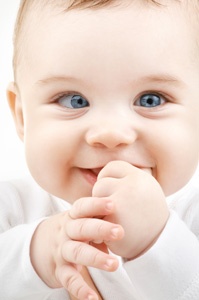For most parents, ensuring their child has good vision is of paramount importance. Many vision problems begin at an early age and children do not always communicate to parents any difficulties they are experiencing with vision. Good vision is essential in childhood development and regular eye examinations are the key to this.
Research has shown that one in five school children have an undetected eye problem. As 80% of a child’s learning occurs visually, many children cannot see well enough to reach their full potential or to enjoy everyday childhood activities as much as they could.
Many parents still assume that their child will have their vision checked at school, regardless of whether this actually happens or not. Vision screening provision is patchy – many areas do not provide it. Even where vision screening is provided in school, there are many conditions which, although may cause significant problems to a child and their ability to learn, will not be picked up at screening. The sooner vision problems are detected, the better the outcome.
It is reported that 30% of children who experience vision problems find it has a significant impact in terms of long-term health, school performance and emotional/social development. Visual difficulties affect children’s ability to learn (being three times more likely to fail at least one grade), resulting in academic under-achievement and a risk of reduced adult literacy. This has a significant impact on professional and social fulfilment. Vision problems cause developmental difficulties and have been linked to antisocial /delinquent behaviour. In the USA, up to 70% of youth offenders have undiagnosed vision problems.
Over 90% of children visit a dentist regularly in comparison to 53% of children who have ever had an eye examination. A child may not realise if their vision is not clear – they assume the way they see is normal. Therefore regular eye examinations are advised for all children under the age of 16 at least once a year. At Hanson’s we take your child’s eyesight every bit as seriously as you do.
Typical Warning Signs To Look Out For
- One eye turns in, out, up or down.
- Complaints of frequent headaches.
- Frequently rubs eyes or blinks a lot.
- Watery eyes.
- Screws up eyes when reading or watching television.
- Avoids reading, writing or drawing.
- Has difficulty catching a ball.
- Fails to make expected progress at school.
- Develops behavioural or concentration problems at school.
Most very young children have their eyesight assessed as part of their routine developmental checks. While these are very important, they aren’t as thorough as a complete eye test by a qualified optician. We recommend that your child have their first eye test by the age of three. The earlier a problem is detected, the more effectively it can be treated.
It doesn’t matter if your child is too young to talk or read a letter chart. We use a range of techniques and modern equipment, such as computerised test charts which allow us to use pictures, numbers, shapes and letters to check vision and detect visual problems in children of any age, making it a fun experience for the children at the same time.
Hanson Opticians provide free NHS eye tests for all children under 16 (including free Fundus photography) and those under 19 and in full time education. If a child is found to need spectacles, a contribution is provided by the NHS.
At Hanson Opticians, we stock a wide range of spectacles specially designed for children with a variety of styles to suit all tastes, including a new line of themed frames featuring kids’ favourite Frozen, Star Wars, minions and Marvel characters as well as a designer range which includes children’s Raybans. Many have soft nose pads for extra comfort and sprung hinges to withstand extra wear and tear. Regular eye examinations are a vital part of your child’s healthcare and personal development, so don’t delay and contact Hanson Opticians for an appointment.
Amblyopia
Amblyopia (often called lazy eye) is a condition that impairs the eyes’ vision. It is caused by a lack of stimulation in the eye and can often be treated by glasses if the condition is spotted soon enough. The sooner it is spotted, the higher the chance of treatment being successful and the better your child’s long-term vision will be.

Strabismus
Similarly to Amblyopia, Strabismus (often called a squint) usually occurs in the early stages of childhood and affects the coordination of the eyes; where one eye points forward, the other could be pointing outward. The sooner it is treated, the greater the chance of recovery, so it is very important that you take your child to be tested if you notice any lack of coordination between the two eyes.
Colour ‘blindness’ Strabismus
 Colour-blindness is a decreased ability to see colour and perceive finer details between differing colours. It is recommended that you have your child tested for colour blindness as it affects 1 in 12 men and 1 in 200 women. Although many can live with colour blindness and not realise it, many types of colour blindness can have an impact on a child’s development. It cannot be cured, however there are multiple ways of managing colour-blindness including colour-tinted spectacles.
Colour-blindness is a decreased ability to see colour and perceive finer details between differing colours. It is recommended that you have your child tested for colour blindness as it affects 1 in 12 men and 1 in 200 women. Although many can live with colour blindness and not realise it, many types of colour blindness can have an impact on a child’s development. It cannot be cured, however there are multiple ways of managing colour-blindness including colour-tinted spectacles.
Protecting your child’s eyes from the sun
Exposure to the sun’s harmful ultraviolet rays can have detrimental effects on the eyes’ health, quickening the development of age-related eye disorders including cataracts and macular degeneration. However, children who spend more time outdoors have the benefit of being less likely to develop short-sightedness. Necessary precautions in protecting your child’s vision include 100% UV protected glasses and making sure they wear a hat with a sun visor.
Change
background
colour:



